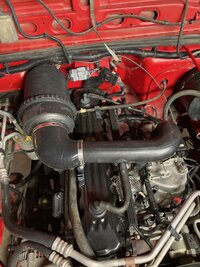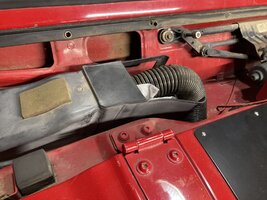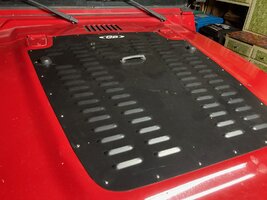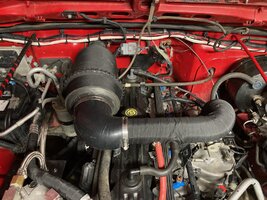Backstory: Ive seen on multiple forums of occasional arguments about CAI kits and out jeeps, I wanted to try and lay some to rest. For those that know, I've been doing this test for quite a while, mainly which this test was done last winter when I would drive to work in the mornings when it was the coldest. I took notes and have written many of my average temps down, but never made a thread about it. Well guess whos doing it now because he has too much free time... Me!
Will a cold air intake give better MPG/performance?
Short answer: No
Long Answer: Nooooooooo(with proof)
Now I know this topic has been touched on quite a bit, but I made this thread to document some of my research I've been doing. I did this “test” because I always hear about people claiming their CAI has given increased performance whether that be HP or MPG. First of all, if the intake is still under the hood, then you are still sucking in all the hot air that radiates from the engine, second, Jeeps on the dyno with a CAI have BARELY any performance gains if any, and the only reason you see a 3-5 hp increase with them on the dyno is most likely due to restriction of airflow, some cars do benefit from a different intake but that is not our case nor is air temp issue an issue, yet I still see people say “But science disagrees with you etc. etc… colder air is better/more efficient”. While that may or may not be true, I wanted to see for myself. I was planning on doing the following mods anyway so I figured I can at least track my data in between one mod to the next since each mod may actually “lower” my IAT. I’ll be using a FoSeal Bluetooth OBDII Scanner with a paired app to track the data.
What is it you’ll do?
I will be monitoring my IAT(Intake Air Temperature) and my coolant temperature and try to get the IAT the lowest at a steady ambient air temperature throughout my daily commute to work to see if lower intake temps give any benefit in performance or MPG.
How do you know your readings will be correct?
By conducting this experiment I wanted to take control of every independent variable I could. Now I can't control the weather, but I made sure to keep note of a 1-2 degree change in weather, using 50 degrees F as our baseline ambient air temperature. That way, I wouldn't be comparing performance in 90 degree weather to 40 degree weather. I want to be as precise as possible. I will also be going the same speed to and from. In the event that the ambient temperature has a vast difference between two days, I will wait until the ambient temperature returns to the 1-2 margin at 50 F for the baseline to concede testing. Im doing a +/- 2 degree margin because its near impossible get 9 weeks of an exact temperature, although I must say, the early mornings stayed between 48-52 degrees fairly consistent.
What about driving(hills/slopes)?
I drive the same route to work each day, 28 miles to and from, same hills, same drive. There is hardly any city driving as it is all freeway. I drive 2 miles and then I'm on the freeway. I will be going at a constant speed of 60 MPH to try and control that variable as well. I will be doing that because according to my OBDII scanner, the IATs will increase or decrease based on my speed and how open the throttle body is(this is due to the “vacuum effect”, for example try sucking in air through pursed lips slow vs fast. Fast will cause colder air due to the diffusion of air which creates a colder temperature when gas particles are in motion). So by driving at a near constant 60 mph with a steady foot should give me a decently accurate reading.
What intake do you have?
While the stock intake with an AcDelco paper filter is argued the best. I am planning on doing highline fenders so I needed to modify it. My current air intake is made from parts of a ford Windstar, 4" to 3" reducing elbow, and the stock intake tube. I'm still using an AcDelco filter since I figured if they make the best filters for our stock airbox, then the filter they make for the Windstar can't be too bad. The intake opening is drilled through the cowl through a sealed unit which technically does give true cold air. Although mine is a little different, I did not have the end piece when I bought my Windstar intake and mine actually sucked up quite a bit of water when it would get into the cowl(learned that at the carwash ) to fix this I used a vacuum tube, RTV’d it to the end of the intake and shoved it into the cab air box. This way, it still gets the cold air from the cowl, while being protected from any water that could potentially make its way in, whether that be from wheeling, rain, car wash etc.
) to fix this I used a vacuum tube, RTV’d it to the end of the intake and shoved it into the cab air box. This way, it still gets the cold air from the cowl, while being protected from any water that could potentially make its way in, whether that be from wheeling, rain, car wash etc.
Heres a pic


It IS known that not running at proper coolant temperatures(engine temps) will give you inefficiency as these engines were designed to run best at the operating temperature of 210° F
The Windstar intake has lowered my intake temp so much to where I would no longer run at 210°F, so I replaced the thermostat with a Stant 205° F instead of the recommended SuperStant 195°F. Now my coolant temps are a steady 202-205, when before they wouldn't even reach 190 and my MPG was noticeably suffering.
Testing:
I will be doing a hood louver, along with wrapping my intake with heat insulation wrap in order to get my temps the lowest to see if that has any additional effect. Keep in mind that I will be showing averages of before and after to show the benefits (if any) of a lower IAT


Each drive to work in the morning gets me an average for Coolant and Intake temps,
MPG=Miles per gallon
IAT= Intake Air Temperature
CT=Coolant Temp
4.0L With 33s and 3.73s/ NV3550 (5 speed manual)
(yes this took me 9 weeks of writing averages down FYI. I enjoyed it!)
Conclusion:
So as you can see from my data above, there isn’t anything to be gained from a lower IAT that these so called CAI kits give, and this is also ignoring the fact that they allow a crap ton of more dirt into your engine(especially brands like K&N!!). The only thing that would truly solidify these tests in my opinion, is if I were to be able to go on a dyno and see my numbers before and after each mod. I did not notice any increase in power or torque. I made this to put some real world evidence out there since I haven't seen much. Plus, I like science and this sort of thing so it gave me something to do Hopefully I was able to put certain arguments to rest as I see these from time to time. I'm hoping I did a good enough job with controlling as many variables as I could, therefore IMHO from my test results I think its safe to say that there was no benefit whatsoever, and I wouldn't waste your money on any different Intake unless you want/need to make space. Granted at the end of the day it's your jeep and as long as you are happy with it that's all that matters
Hopefully I was able to put certain arguments to rest as I see these from time to time. I'm hoping I did a good enough job with controlling as many variables as I could, therefore IMHO from my test results I think its safe to say that there was no benefit whatsoever, and I wouldn't waste your money on any different Intake unless you want/need to make space. Granted at the end of the day it's your jeep and as long as you are happy with it that's all that matters  Thanks for reading folks.
Thanks for reading folks.
Will a cold air intake give better MPG/performance?
Short answer: No
Long Answer: Nooooooooo(with proof)
Now I know this topic has been touched on quite a bit, but I made this thread to document some of my research I've been doing. I did this “test” because I always hear about people claiming their CAI has given increased performance whether that be HP or MPG. First of all, if the intake is still under the hood, then you are still sucking in all the hot air that radiates from the engine, second, Jeeps on the dyno with a CAI have BARELY any performance gains if any, and the only reason you see a 3-5 hp increase with them on the dyno is most likely due to restriction of airflow, some cars do benefit from a different intake but that is not our case nor is air temp issue an issue, yet I still see people say “But science disagrees with you etc. etc… colder air is better/more efficient”. While that may or may not be true, I wanted to see for myself. I was planning on doing the following mods anyway so I figured I can at least track my data in between one mod to the next since each mod may actually “lower” my IAT. I’ll be using a FoSeal Bluetooth OBDII Scanner with a paired app to track the data.
What is it you’ll do?
I will be monitoring my IAT(Intake Air Temperature) and my coolant temperature and try to get the IAT the lowest at a steady ambient air temperature throughout my daily commute to work to see if lower intake temps give any benefit in performance or MPG.
How do you know your readings will be correct?
By conducting this experiment I wanted to take control of every independent variable I could. Now I can't control the weather, but I made sure to keep note of a 1-2 degree change in weather, using 50 degrees F as our baseline ambient air temperature. That way, I wouldn't be comparing performance in 90 degree weather to 40 degree weather. I want to be as precise as possible. I will also be going the same speed to and from. In the event that the ambient temperature has a vast difference between two days, I will wait until the ambient temperature returns to the 1-2 margin at 50 F for the baseline to concede testing. Im doing a +/- 2 degree margin because its near impossible get 9 weeks of an exact temperature, although I must say, the early mornings stayed between 48-52 degrees fairly consistent.
What about driving(hills/slopes)?
I drive the same route to work each day, 28 miles to and from, same hills, same drive. There is hardly any city driving as it is all freeway. I drive 2 miles and then I'm on the freeway. I will be going at a constant speed of 60 MPH to try and control that variable as well. I will be doing that because according to my OBDII scanner, the IATs will increase or decrease based on my speed and how open the throttle body is(this is due to the “vacuum effect”, for example try sucking in air through pursed lips slow vs fast. Fast will cause colder air due to the diffusion of air which creates a colder temperature when gas particles are in motion). So by driving at a near constant 60 mph with a steady foot should give me a decently accurate reading.
What intake do you have?
While the stock intake with an AcDelco paper filter is argued the best. I am planning on doing highline fenders so I needed to modify it. My current air intake is made from parts of a ford Windstar, 4" to 3" reducing elbow, and the stock intake tube. I'm still using an AcDelco filter since I figured if they make the best filters for our stock airbox, then the filter they make for the Windstar can't be too bad. The intake opening is drilled through the cowl through a sealed unit which technically does give true cold air. Although mine is a little different, I did not have the end piece when I bought my Windstar intake and mine actually sucked up quite a bit of water when it would get into the cowl(learned that at the carwash
Heres a pic


It IS known that not running at proper coolant temperatures(engine temps) will give you inefficiency as these engines were designed to run best at the operating temperature of 210° F
The Windstar intake has lowered my intake temp so much to where I would no longer run at 210°F, so I replaced the thermostat with a Stant 205° F instead of the recommended SuperStant 195°F. Now my coolant temps are a steady 202-205, when before they wouldn't even reach 190 and my MPG was noticeably suffering.
Testing:
I will be doing a hood louver, along with wrapping my intake with heat insulation wrap in order to get my temps the lowest to see if that has any additional effect. Keep in mind that I will be showing averages of before and after to show the benefits (if any) of a lower IAT


Each drive to work in the morning gets me an average for Coolant and Intake temps,
MPG=Miles per gallon
IAT= Intake Air Temperature
CT=Coolant Temp
4.0L With 33s and 3.73s/ NV3550 (5 speed manual)
| Averages in 50° F (+/- 2°) | Week 1 | Week 2 | Week 3 | Avg Total | |
| Windstar intake | MPG=14.1 IAT=75.2 CT=203 | MPG=14.2 IAT=75.2 CT=203 | MPG=14.1 IAT=75.4 CT=202 | MPG=14.13 IAT=75.26 CT=202.6 | |
| Heat wrap | MPG=14.2 IAT=71.6 CT=202 | MPG=14.3 IAT=72 CT=203 | MPG=14.2 IAT=71.8 CT=202 | MPG=14.23 IAT=71.8 CT=202.3 | |
| Heat Wrap and louver louver | MPG=14.2 IAT=68 CT=203 | MPG=14.1 IAT=67.6 CT=203 | MPG= 14.2 IAT=68 CT=203 | MPG=14.16 IAT=67.83 CT=203 |
Conclusion:
So as you can see from my data above, there isn’t anything to be gained from a lower IAT that these so called CAI kits give, and this is also ignoring the fact that they allow a crap ton of more dirt into your engine(especially brands like K&N!!). The only thing that would truly solidify these tests in my opinion, is if I were to be able to go on a dyno and see my numbers before and after each mod. I did not notice any increase in power or torque. I made this to put some real world evidence out there since I haven't seen much. Plus, I like science and this sort of thing so it gave me something to do

